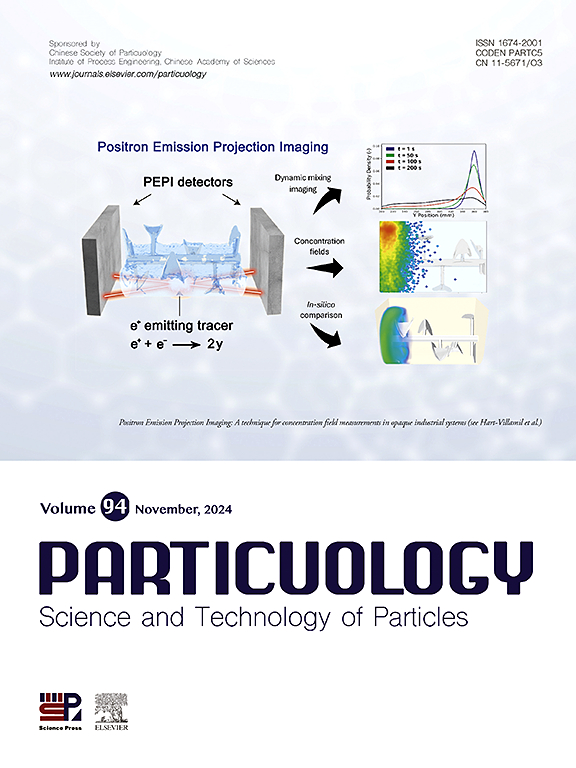Design and performance evaluation of a paint particle dispersion reduction device for airless spraying
IF 4.3
2区 材料科学
Q2 ENGINEERING, CHEMICAL
引用次数: 0
Abstract
Airless spray painting, widely adopted for its efficiency and cost-effectiveness, generates a significant amount of airborne paint particles that contribute to air pollution and pose health risks to workers and nearby residents. In this study, a paint particle dispersion reduction device (PPDRD) utilizing an axial cyclone separator and a high efficiency particulate air (HEPA) filter was designed and evaluated to minimize the dispersion of paint particles during airless spray applications. The cyclone separator captured larger paint particles through centrifugal force, while the HEPA filter effectively removed smaller particles that escaped the cyclone separator. Computational fluid dynamics (CFD) simulations were conducted to optimize key design parameters, including the number and height of guide vanes and suction flow rate. Lab-scale and field experiments demonstrated that the PPDRD significantly reduced airborne paint particles, with respirable particles (4 μm or smaller) decreasing by 50–80 % depending on particle size, while maintaining coating quality. These findings indicate that the PPDRD effectively mitigates the inhalation risks associated with hazardous paint aerosols, providing a practical solution for improving workplace safety and environmental compliance. This technology is expected to be widely applicable in exterior building painting, shipbuilding, and the automotive industry.

无气喷涂用油漆颗粒分散减少装置的设计与性能评价
无气喷漆因其效率和成本效益而被广泛采用,但它会产生大量空气中的油漆颗粒,造成空气污染,并对工人和附近居民的健康构成威胁。在本研究中,设计并评估了一种利用轴向旋风分离器和高效颗粒空气(HEPA)过滤器的油漆颗粒分散减少装置(PPDRD),以最大限度地减少无空气喷涂过程中油漆颗粒的分散。旋风分离器通过离心力捕获较大的油漆颗粒,而HEPA过滤器有效地去除逃离旋风分离器的较小颗粒。通过计算流体动力学(CFD)模拟,优化了包括导叶数量、导叶高度和吸力流量在内的关键设计参数。实验室规模和现场实验表明,PPDRD显著减少了空气中的油漆颗粒,根据颗粒大小的不同,可吸入颗粒(4 μm或更小)减少了50 - 80%,同时保持了涂料质量。这些研究结果表明,PPDRD有效地减轻了与有害油漆气溶胶相关的吸入风险,为提高工作场所安全和环境合规性提供了切实可行的解决方案。该技术有望广泛应用于建筑外墙涂装、造船、汽车等行业。
本文章由计算机程序翻译,如有差异,请以英文原文为准。
求助全文
约1分钟内获得全文
求助全文
来源期刊

Particuology
工程技术-材料科学:综合
CiteScore
6.70
自引率
2.90%
发文量
1730
审稿时长
32 days
期刊介绍:
The word ‘particuology’ was coined to parallel the discipline for the science and technology of particles.
Particuology is an interdisciplinary journal that publishes frontier research articles and critical reviews on the discovery, formulation and engineering of particulate materials, processes and systems. It especially welcomes contributions utilising advanced theoretical, modelling and measurement methods to enable the discovery and creation of new particulate materials, and the manufacturing of functional particulate-based products, such as sensors.
Papers are handled by Thematic Editors who oversee contributions from specific subject fields. These fields are classified into: Particle Synthesis and Modification; Particle Characterization and Measurement; Granular Systems and Bulk Solids Technology; Fluidization and Particle-Fluid Systems; Aerosols; and Applications of Particle Technology.
Key topics concerning the creation and processing of particulates include:
-Modelling and simulation of particle formation, collective behaviour of particles and systems for particle production over a broad spectrum of length scales
-Mining of experimental data for particle synthesis and surface properties to facilitate the creation of new materials and processes
-Particle design and preparation including controlled response and sensing functionalities in formation, delivery systems and biological systems, etc.
-Experimental and computational methods for visualization and analysis of particulate system.
These topics are broadly relevant to the production of materials, pharmaceuticals and food, and to the conversion of energy resources to fuels and protection of the environment.
 求助内容:
求助内容: 应助结果提醒方式:
应助结果提醒方式:


